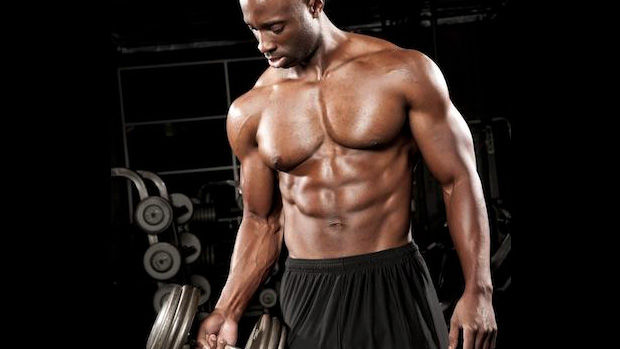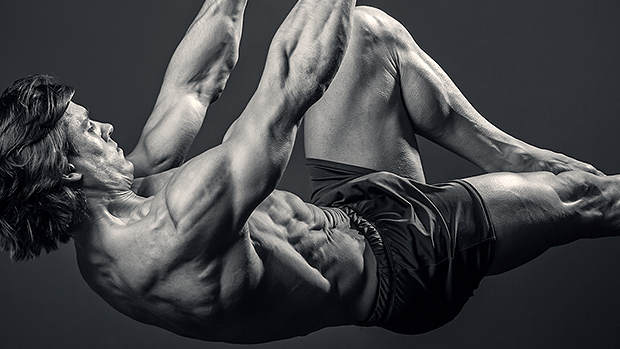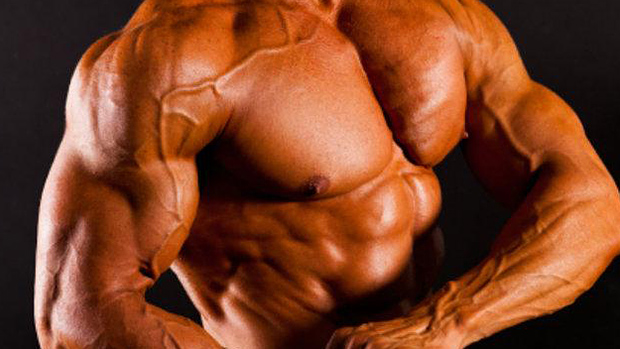This new Q & A column is about building a muscular and aesthetic physique. It's not about breaking strength records or reaching speed and power personal bests.
A lot of T Nation readers are training only to improve their appearance, and even if the current trend is to dismiss these individuals training only for aesthetic purposes, I think it's perfectly fine to train that way. Training hard to build a great body is just as difficult, if not more difficult, than training to improve performance. It's about time people realized it.
You wanna train to look good? Don't be ashamed to say it!
Before getting it on, I want to make it clear that lifting weight isn't simply lifting weight. Weights (including machines) are only tools we use to reach our goals. So if you're training to build muscle, build strength, or improve performance, the way you use these tools will be highly variable.
In this column, I'll discuss ways of using weights to build an aesthetic and muscular body. While some of that info can be used to improve strength and performance, that's not the main goal of this column.
With that out of the way, let's get started!
T Nation: I have a problem when trying to build up my triceps. Whenever I perform close-grip bench presses, I do feel it somewhat in my triceps, but I actually get a huge chest pump. When the set is completed, I feel that my triceps aren't fully stimulated. What gives?
Coach Thibaudeau: All types of pressing movements (dumbbells, barbell, machine; decline, flat, incline, or standing; close-grip, moderate grip, or wide grip) involve the triceps, pectorals, and deltoids to some extent.
Your body is very keen on effort-economy, meaning that it'll always look for the most energy efficient way of performing a movement. If your pecs are very strong and your triceps are weak, the chest will take on more of the workload during a close-grip bench press.
The result is that the chest will get fully stimulated while the triceps won't be thoroughly fatigued. Remember, a motor-unit and its muscle fibers that aren't recruited or fully fatigued aren't stimulated and won't grow (Zatsiorsky ,1995). So if your triceps aren't maximally taxed after your set, chances are that they won't grow as much as they could.
Some people will thus recommend dropping the close-grip bench press in favor of more isolation work for the triceps. While this can work to some extent, they forget that compound movements carry higher growth stimulation potential than isolation exercises because they allow you to place the muscle groups under a heavier load.
So, a more effective way of correcting your problem would be to keep the close-grip bench press, but perform it in a way that will allow the triceps to receive more training stress. The answer is to use the double-contraction training technique (also called one and a half reps). Specifically, you'll perform twice as many "triceps reps" as "chest-dominant reps."
As you can see from the picture below, the bulk of the work is switched to the triceps in the later portion of the movement near the lockout. So if we want to accentuate the importance of the triceps in the exercise, we should perform more work in that portion of the range of motion.

The strategy to use is very simple: each rep should comprise a full stroke followed by a half stroke. So, on each rep you'll:
- Lower the bar to the chest.
- Press it back up to the starting position.
- Lower the bar halfway down.
- Press it back up to the starting position.
This is one repetition. So if you're performing sets of six reps, your triceps will actually get twice as much work as the chest!
T Nation: I really want to build up my chest. Are dumbbell flyes any good?
Coach Thibaudeau: Dumbbell flyes are a traditional exercise in most bodybuilding programs. Bodybuilders have been performing them since the beginning of time, so they're universally recognized as a very effective exercise. But are they really?
Well, yes and no. Only the first half of the flye motion is actually a decent pectoral exercise! See the illustration below.

For an exercise to be effective at stimulating a muscle group, the direction of the effort must be opposite to the direction of the resistance: the closer it is from a direct opposition, the greater the activity of the targeted muscle group.
When using free-weights, the direction of the resistance is always downward (in-line with the gravity pull). So when working with free-weights, the greater muscle activation will be achieved when you're lifting straight up.
With the flye, you're moving the weights directly against the resistance during the first portion of the exercise (green zone in pic above). At that point you're thus placing a training stress equivalent to 100% of the weight of the dumbbells. As you reach the later part of the movement's range of motion, the amount of resistance decreases.
In the yellow zone you're placing around 60-75% of the weight of the dumbbells in training stress, down to 30-50% in the orange zone, and close to 0 in the red zone.
Actually, once you reach the orange and red zones, the pectoral muscles will actually lose tension. Some people will argue that when you purposefully squeeze them at that point you're still getting a maximum effort, but that isn't true as you're contracting against a very low resistance.
For bodybuilding purposes, it's more effective to maintain a maximum amount of muscle tension during the whole exercise. This is especially true of isolation movements such as flyes. So in that regard, the last half of the flye movement not only is of no use as far as building muscle goes, but it can actually reduce the general efficacy of the exercise!
For flyes to be an effective exercise, you should only perform around two-thirds of the range of motion, but really focus on getting the deepest stretch possible in the low position of the movement. Keep the pace of the exercise relatively slow while focusing on keeping the pecs tight and tensed the whole time.
Note that this reasoning doesn't apply to flyes performed on a cable station since the pulley adjusts the direction of the resistance to fit the direction of effort. So when performing flyes on a dual pulley station, you should perform a full range of motion.
T Nation: My bench press strength has gone up a lot in the past two months, but my pecs haven't gotten thicker at all. My arms look bigger but my chest is still flat. How can that be?
Coach Thibaudeau: It's probably because your triceps are so strong that they take on a greater portion of the work, so your pecs are left less-than-optimally stimulated from your bench pressing. The sad thing is that if you don't do anything about it, the situation will only get worst!
Why? As I mentioned in my earlier response, the body will switch more of the workload to the strongest muscles in a movement. If your triceps are very strong, they'll take on much of the work during any pressing exercise. As a result, they'll also receive more stimulation and will thus grow more and gain more strength. As they grow stronger they'll still take on more work during pressing movements. It's a vicious circle!
There will come a point where your triceps will be so much stronger than your chest that building-up the latter will become almost impossible! What can you do? Here are a few suggestions:
1 Using the double contraction technique in the low position.
Remember the illustration I used earlier?

Well, if we used double contraction in the high position to build up the triceps, we can do the opposite to build the pecs. So each rep of a set will now look like this:
- Lower the bar down to the chest.
- Press it halfway up.
- Lower it back down to the chest.
- Press it up completely.
This is one rep. So as you can see, the pecs will receive twice as many reps as the triceps. An important point is to execute the first half-rep under muscular control (squeeze the pecs). Many people bounce or spring the bar up during that first portion, which takes a lot of stress (and thus growth stimulation) off of the muscle structure of the chest.
2 Use the post-fatigue technique.
This method refers to a superset (no rest between two movements) of two exercises for the same muscle group. The first exercise is the compound lift (bench press) and the second one is an isolation exercise for the target muscle group. In your case it could be cable flyes.
Perform your bench press set and immediately move on to the flyes. What this does is "finish off" the pectoral fibers that were left not fully stimulated from the bench pressing. As a result they'll receive a maximum growth stimulus.
3 – Place the triceps in a mechanically disadvantaged position.
If the triceps are placed in such a position as their contribution to the movement is harder, the body will have to rely on other muscle groups (the pecs) to do the work.
In the case of the bench press, it means using a wider grip and lowering the bar closer to the upper pec region instead of the middle portion. This will recruit the chest more. However, it also places more stress on the shoulder joint. If you have any shoulder problems, you should be careful.

The picture above is of Canadian bobsled athlete Pascal Caron. Why am I showing you a picture of a half-naked man? Because Pascal naturally benches with a wide grip. That's how he was first taught to bench press and he's always used this method.
Now, his best bench press is 425 (at a bodyweight of 167 pounds) and he has virtually no triceps at all! However, his chest is super thick (even more so than the pic shows because of the angle). This is a real life example of what changing the technique of an exercise can do for specific muscle development.
T Nation: Do you have any secret biceps workout to share? My problem is that I don't have a lot of time to train. Is there any way to get huge guns without spending much time in the gym?
Coach Thibaudeau: While I've written a super arm program in my article Armed For Combat, I understand your problem about not having a lot of time to train. So here's a quick-hitter. It's a program I used with Sebastien Cossette with great results.
A1. Isometric Steep Preacher Curl
For this one you have to use the end of the Scott bench that's perpendicular to the floor. Hold the weight in a position where your forearm is parallel to the floor. Keep the wrist in flexion too. Hold that position for 30-45 seconds. If you can hold it longer than 45 seconds, add some weight.
Method: yielding isometric
A2. Alternate Standing Dumbbell Curl
Start with the palms facing your body. As you curl the weight up you'll supinate (turn the palms towards the ceiling).
Method: drop set (Start with a weight you can lift 8 times, then reduce the weight so that you can get 4-5 more reps.)
A3. Reverse Grip Standing Barbell Curl
Reps: 12 to 15
Method: normal execution
There's no rest between A1, A2 and A3. After A3 you take 90 seconds of rest and repeat the giant set three times. This workout should take you around 10-15 minutes and will thoroughly destroy your biceps!
Hope you enjoyed this first installment! With each new article you're sure to learn a thing or two that'll propel your muscular development to new heights!





